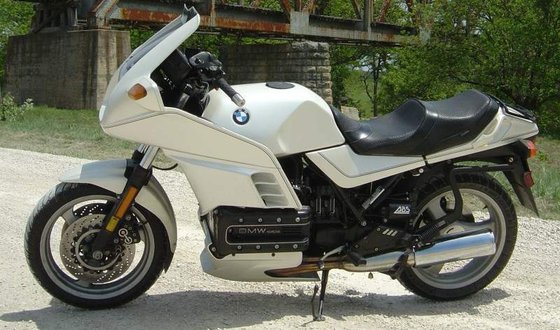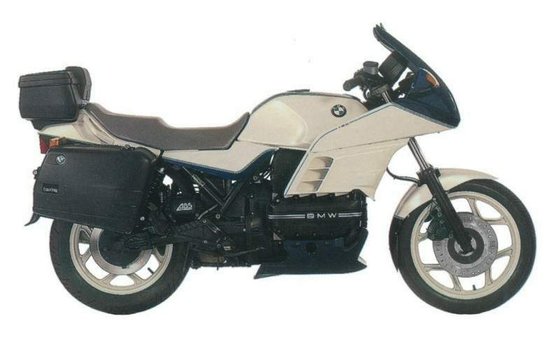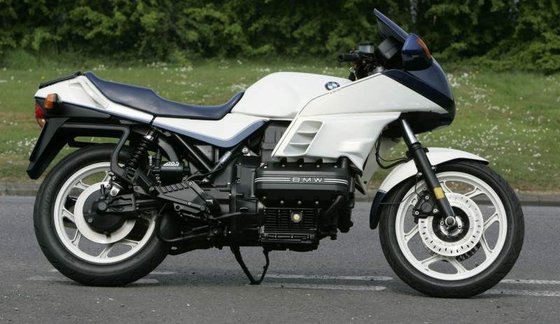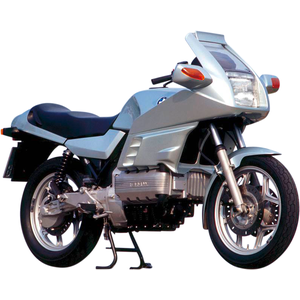BMW K 100 RS [1989-1992]: A Timeless Sport-Touring Contender Revisited

Introduction
The BMW K 100 RS—produced between 1989 and 1992—remains a fascinating study in how BMW balanced innovation with practicality during an era when sport-touring motorcycles were redefining long-distance performance. With its horizontally mounted inline-four engine, aerodynamic fairing, and advanced (for its time) Bosch Motronic fuel injection, the K 100 RS was a machine that dared to be different. Riding this bike today feels like stepping into a time capsule where analog engineering meets forward-thinking design. Let’s explore what makes this generation of the K 100 RS a cult classic among enthusiasts and a viable platform for modern riders seeking retro-modern charm.
Engine Performance: The Heart of the Beast
Power Delivery and Character
At the core of the K 100 RS lies its 987cc liquid-cooled inline-four engine, producing 100 HP (74 kW) at 8,000 RPM and 86 Nm (63 ft-lb) of torque at 6,000 RPM. Unlike the high-strung scream of Japanese inline-fours, the BMW’s powerplant prioritizes low-end grunt and mid-range authority. The engine’s horizontal orientation—a rarity in the motorcycle world—lowers the center of gravity, giving the bike a planted feel even at full lean.
Throttle response from the Bosch Motronic fuel injection is smooth and predictable, though not as razor-sharp as modern ride-by-wire systems. The engine thrives between 3,000–7,000 RPM, pulling strongly from village speeds to autobahn dashes. Redline sits at 8,500 RPM, but the real magic happens in the mid-range, where the torque curve flattens out, making overtaking or climbing mountain passes effortless.
Shaft Drive: Love It or Tolerate It
The Paralever shaft drive eliminates chain maintenance hassles and delivers buttery-smooth power transfer. While purists might miss the visceral feedback of a chain-driven bike, the shaft’s reliability and low upkeep align perfectly with the K 100 RS’s touring ethos. That said, the system adds weight—noticeable when pushing the bike hard into corners—and a slight driveline lash when rolling on/off the throttle abruptly.

Handling and Ride Dynamics
Chassis and Suspension
The K 100 RS’s tubular space frame, with the engine acting as a stressed member, strikes a fine balance between rigidity and compliance. Up front, the 41.7mm Marzocchi fork (185mm/7.3in of travel) offers plush damping over rough surfaces, while the rear monoshock (110mm/4.3in of travel) provides three preload settings to accommodate solo or two-up riding.
At 263 kg (579 lbs) wet, the K 100 RS isn’t light, but its weight distribution hides the heft well. The bike feels stable at highway speeds, with the 1516mm (59.7in) wheelbase contributing to confident straight-line tracking. However, transitioning through tight switchbacks requires deliberate countersteering—this isn’t a flickable sportbike, but a mile-eating tourer that rewards smooth inputs.
Brakes and ABS (Optional)
Dual 285mm front discs with two-piston calipers and a single rear disc provide strong, linear stopping power. The optional ABS—a novelty in the early ’90s—adds peace of mind in wet conditions, though its engagement feels abrupt compared to modern systems.
Comfort and Ergonomics: Designed for the Long Haul
Riding Position
The K 100 RS’s 800mm (31.5in) seat height accommodates riders of average stature, while the slightly rear-set pegs and 24-inch handlebar create a relaxed yet sporty posture. The seat itself is firm—a BMW trademark—but supportive enough for 2–3 hour stints before demanding a stretch break.
Wind Protection
The full fairing and adjustable windscreen create a quiet pocket of air, directing turbulence over the rider’s helmet. At 220 km/h (136 mph), buffeting is minimal, though taller riders might wish for an extra inch of screen height.
Fuel Efficiency and Range
With an average consumption of 4.7 L/100 km (50 US mpg), the 19.7L (5.2-gallon) tank delivers a 250-mile range—enough to outlast most bladders. The fuel warning light (triggered at 4.9L/1.3 gallons) gives ample time to refuel.

Competition: How Does the K 100 RS Stack Up?
Honda VFR750F (1990–1993)
Honda’s V4-powered VFR750F rivaled the BMW with its 100 HP output and iconic gear-driven camshaft whine. While the Honda was lighter and nimbler, it lacked the K 100 RS’s shaft drive and wind protection. Maintenance intervals were shorter too, thanks to its high-revving V4 and chain final drive.
Yamaha FJ1200 (1984–1996)
Yamaha’s air-cooled inline-four FJ1200 offered brute force (125 HP) and a roomier saddle, but its outdated chassis and suspension struggled to keep pace with the BMW’s refinement. The Yamaha’s chain drive also demanded frequent adjustments on long trips.
Kawasaki GPz900R (1984–1996)
The GPz900R (made famous by Top Gun) prioritized sportiness over comfort, with a razor-sharp frame and 115 HP engine. However, its cramped ergonomics and lack of weather protection made it less versatile than the K 100 RS for touring.
Verdict: The BMW carved a niche with its blend of tech (shaft drive, fuel injection), comfort, and durability. It wasn’t the fastest or lightest, but it aged gracefully—a trait its Japanese competitors couldn’t match.
Maintenance: Keeping the K 100 RS Alive
Key Considerations
- Valve Adjustments: The DOHC 16-valve engine requires checking valve clearances every 10,000 km (6,200 miles). Intake valves: 0.15–0.20mm (0.006–0.008in), exhaust: 0.25–0.30mm (0.010–0.012in). Shims are bucket-type, simplifying adjustments.
- Oil Changes: Use SAE 20W-50 (3.75L with filter). The wet sump design ensures consistent lubrication, even during aggressive cornering.
- Shaft Drive: Replace final drive oil (260ml SAE 90 GL-5) every 20,000 km (12,400 miles). Inspect the Paralever bearings for play during service.
- Tires: The OEM 120/70-ZR17 front and 160/60-ZR18 rear radials strike a good balance between grip and longevity. Maintain pressures at 2.2 bar (32 psi) front and 2.5 bar (36 psi) rear for solo riding.
Common Upgrades from MOTOPARTS.store
- Aftermarket Seats: Swap the factory plank for a gel or memory foam saddle.
- Modern Suspension: Retrofit adjustable shocks or cartridge emulators for improved damping.
- LED Lighting: Boost visibility with plug-and-play LED headlights and turn signals.
- Exhaust Systems: Lightweight stainless-steel headers reduce weight and enhance the inline-four’s growl.
Conclusion: A Legacy Worth Preserving
The BMW K 100 RS 16V isn’t just a relic—it’s a testament to an era when motorcycles were built to last. Its torquey engine, shaft drive, and ergonomic design make it a joy to ride even today, while its mechanical simplicity ensures DIY-friendly maintenance. For riders seeking a classic sport-tourer with modern-day usability, the K 100 RS remains a compelling choice. And with MOTOPARTS.store’s extensive catalog of upgrades and OEM replacements, keeping this Bavarian icon on the road has never been easier.
Specifications sheet
| Engine | |
|---|---|
| Stroke: | Four-stroke |
| Max power: | 74 kW | 99.0 hp |
| Max torque: | 86 Nm |
| Fuel system: | Bosch Motronic fuel injection |
| Max power @: | 8000 rpm |
| Displacement: | 987 ccm |
| Max torque @: | 6000 rpm |
| Bore x stroke: | 67.0 x 70.0 mm (2.6 x 2.8 in) |
| Configuration: | Inline |
| Cooling system: | Liquid |
| Compression ratio: | 11.0:1 |
| Number of cylinders: | 4 |
| Valves per cylinder: | 4 |
| Dimensions | |
|---|---|
| Wheelbase: | 1516 mm (59.7 in) |
| Dry weight: | 253 |
| Wet weight: | 263 |
| Seat height: | 800 mm (31.5 in) |
| Overall width: | 800 mm (31.5 in) |
| Overall height: | 1271 mm (50.0 in) |
| Overall length: | 2220 mm (87.4 in) |
| Ground clearance: | 175 mm (6.9 in) |
| Fuel tank capacity: | 22 L (5.8 US gal) |
| Drivetrain | |
|---|---|
| Gear ratio: | 1st 4.50 / 2nd 2.96 / 3rd 2.30 / 4th 1.88 / 5th 1.61:1 |
| Final drive: | shaft |
| Transmission: | 5-speed |
| Electrical | |
|---|---|
| Battery: | 20Ah |
| Starting system: | Electric |
| Maintenance | |
|---|---|
| Rear tire: | 160/60-18 |
| Engine oil: | 20W50 |
| Front tire: | 120/70-17 |
| Brake fluid: | DOT 4 |
| Gearbox oil: | 0.85 L SAE 90 GL-5 |
| Spark plugs: | NGK D7EA, NGK DR7EIX |
| Spark plug gap: | 0.6 |
| Final drive oil: | 0.26 L SAE 90 GL-5 |
| Coolant capacity: | 3.2 |
| Forks oil capacity: | 0.8 |
| Engine oil capacity: | 3.75 |
| Valve clearance (intake, cold): | 0.15–0.20 mm |
| Valve clearance (exhaust, cold): | 0.25–0.30 mm |
| Recommended tire pressure (rear): | 2.5 bar (36 psi) |
| Recommended tire pressure (front): | 2.2 bar (32 psi) |
| Chassis and Suspension | |
|---|---|
| Frame: | Tubular space frame with engine as stressed member |
| Rear tire: | 160/60-z-18 |
| Front tire: | 120/70-z-17 |
| Rear brakes: | Single 285 mm disc, 1-piston caliper (ABS optional) |
| Front brakes: | Dual 285 mm discs, 2-piston calipers (ABS optional) |
| Rear suspension: | Monoshock swinging arm, adjustable preload, 110 mm travel |
| Front suspension: | 41.7 mm Marzocchi telescopic fork, 185 mm travel |



















